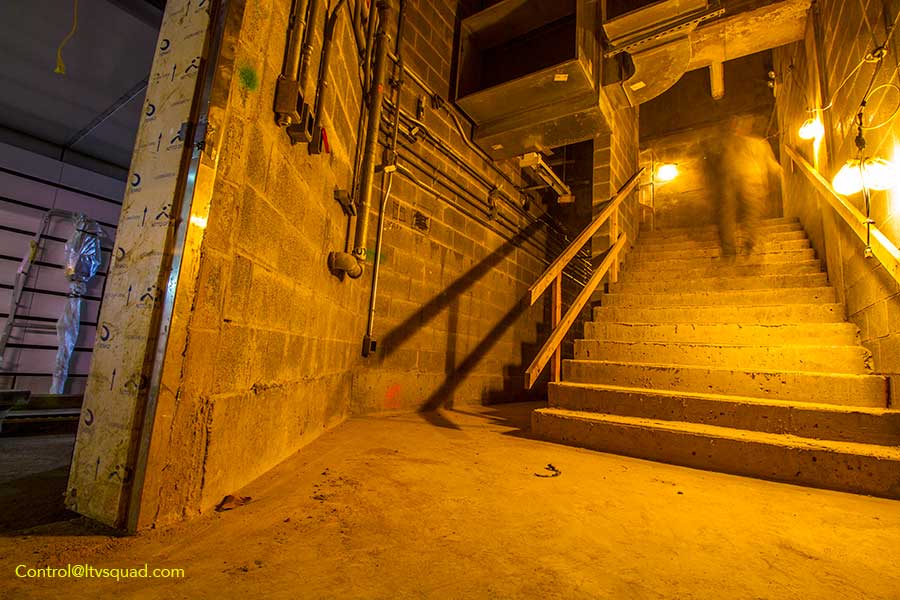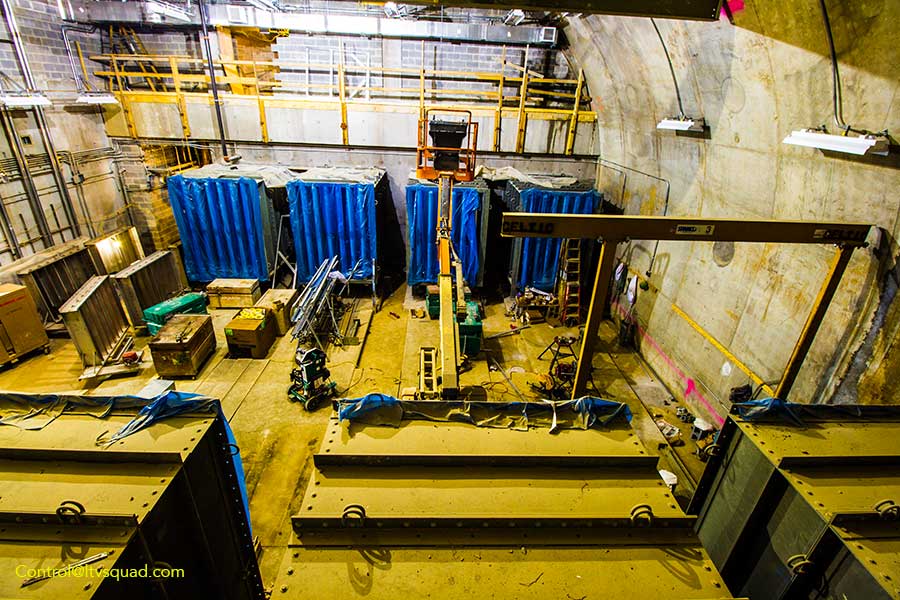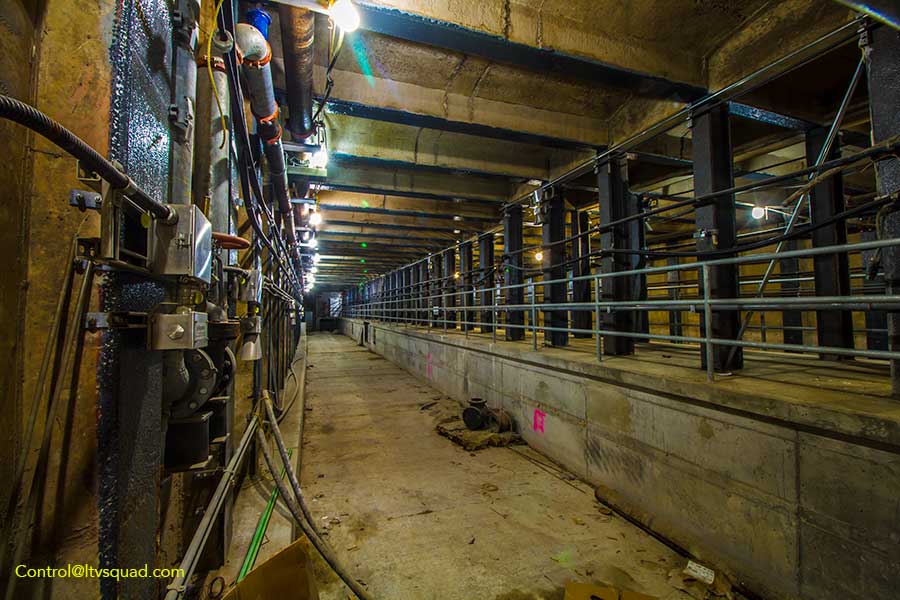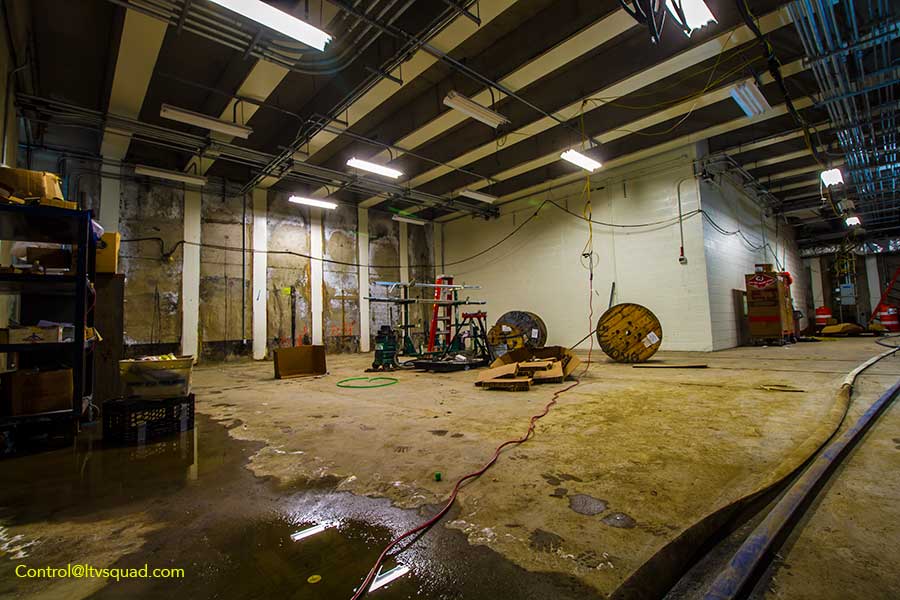
As the first phase of the second avenue subway finally opens, it is important to note a few interesting distinctions.

Pump room between the tracks.
In nearly every NYC subway tunnel, you will find at least one emergency exit. These exits are usually located roughly halfway between stations, and consist of a set of stairs leading to a hatch on the sidewalks above. These exits are generally only used in extreme situations, such as train derailments and blackouts.
The tunnels between 63rd, 72nd, 86th and 96th street stations are completely bereft of exits. For much of the route, between 72nd and 96th streets, the two parallel tunnels are only linked by occasional pump rooms between the tracks, which do not provide access to the streets far above.
There are hidden exits just beyond each platform, though they are part of the caverns for each station, and hidden in utility areas. We’ll get to those in a second…

South of 72nd street station, the the new tunnel runs straight for a few blocks before curving to connect with the 63rd street tunnel. Before the tunnel begins curving away though, a very large provisional cavern has been created, where a set of tunnels can easily connect for their eventual trip all the way to downtown Manhattan and perhaps Brooklyn.

Hidden exit stairs
In the massive hidden sections of each new station one can get a sense for why each was so expensive to construct. These utility areas contain an enormous complex of ventilation and power supply equipment. There are also strange new ‘in station’ emergency exits, which consist of small stairs leading to doorways in the new surface ventilation buildings, along with varied crew rooms, bathrooms, and other work spaces.

HVAC room under construction – all three new stations contain similar rooms

Back in the 1970s, three sections of the 2nd avenue subway were completed: One under chinatown, a second between 99th and 105 streets, and the third running from 110th to 120th streets.
The 99th to 105th street tunnel is now attached to the new 63rd street to 96th street tunnel. Beyond 96th street, the new tunnel runs a few more blocks north, where the tracks end at a temporary cinder block wall. A doorway in this wall leads into the 1970s segment. Entering this tunnel was a downright creepy experience, as a sewage pump at the far north end makes a completely alien sound slurping up muck and water. At the east side of this tunnel segment there is a utility room with stairs marked ‘105th street’. I didn’t personally pop this hatch to see if it indeed comes out at 105th street, though others report it does. This tunnel segment also showed plenty of signs of age and rust consistent with the 110-120th street tunnel segment.

1970s Utility area
It was recently announced that Phase 2 of the Second Avenue Subway was projected to cost of six billion dollars. The price-tag is astonishing considering the existence of the 110th to 120th street tunnel. While that segment does not contain stations, much of it contains a center trackway originally intended for use repairing & inspecting trains. This space could be converted to a center island platform, significantly reducing construction cost. The 110-120 segment is also not very far underground, which would drastically reduce costs. The rumor mill has it that the MTA has decided the 110-120 street segment can’t be used. No reason has been given for this determination, and I question the validity of this rumor not only on the lack of named sources, but the fact that the phase 1 tunnel would require a steep downward grade from 105th street for the MTA to run a tunnel underneath this existing segment.
If this rumor is debunked, the price-tag for phase two becomes all the more disturbing. The six billion dollars would literally be used for constructing only 12 city blocks of subway tunnel (from 105 to 110th, and from 120 & 2nd over to 125th and Lexington ave). Measured on google maps, this is a distance of 3,800 feet – less than one mile. A six billion dollar price-tag for a tunnel that is already half built, and requires less than a mile of new tunnel to finish is frankly unacceptable. If you agree, by all means contact the governors office and make sure Cuomo knows that bringing these costs under control is paramount. There are few known reasons why this six billion dollar cost cannot be slashed to a much more realistic number, with the project completed far faster than current projections.

The 110-120 segment, looking down on the center trackway
There is the potential that the MTA and elected officials are just gaslighting us. Perhaps they are planning to use the 110-120 segment, and will announce that costs will be greatly reduced. Just yesterday the MTA was dialing back against this rumor in the Wall Street Journal. One could easily imagine a press conference announcing this, with elected officials patting themselves on the back as heros. After all the 110-120 tunnel segment may not be widely known, but it is no secret. It has been listed on Wikipedia for quite some time. We published the first significant photos of this tunnel segment way back in 2008 – nearly nine years ago. The tunnel also made headline news in 2011 when a few of my friends were detained for exploring this tunnel.
Whatever the future holds for the next phases of the second avenue subway, we’ll remain eager to see if and how these new tunnels evolve. Despite all the politics, it is nice to see continued progress in adding new routes and new commuting options. With the population of NYC projected to break the 9 million threshold in coming years, the city desperately needs every last inch of new subway it can get. These new transit routes must be built economically. We cannot afford to blow any more billions of dollars on over budget boondoggles such as the new WTC Path station. Four billion dollars could have gone towards construction of the Utica avenue subway in Brooklyn. It could have easily paid for the reopening of the LIRR Rockaway Beach Branch, serving huge, transit starved neighborhoods in Queens. There’s no shortage of new transit routes that need to be built – and the only way any of them will happen is if we, the people, hold our politicians feet to the fire to not only get these essential projects started, but do so economically.
Do the tracks themselves go all the way to 105th Street?
Interesting. Can’t wait for it to open tomorrow, but the fact that there’s no EE’s along the way freaks me out a little.
No – only to around I believe 98th or 99th streets. After that there are bumper blocks, and a temporary wall with doorways into the 70’s section.
Thank you. These pictures are great! I would think that it is 99th.
I explored this section of tunnel back in October. Walked from Lex/63rd all the way up to 105th Street underground, it was a hell of a trip.
There is an emergency exit that leads up to 105th St. in the utility room, but it was bolted shut and there was no way to get out. So I walked back along the tracks to an emergency exit that led me to 102nd St.
I lived on 105th and second and that exit was right in front of my building. 302 east 105. They gate was welded shut until a few years when they built a temp house above it.
$6B is crazy. The whole line is about $2B/mile and that average makes this short segment out to be 4 times as costly? I understand that there is extra infrastructure needed for a terminal station, but seriously. And yes, rebuild the Rockaway Beach Branch for subway service.
Bedrock at/around 125th street is likely too deep to make the existing 110-120th tunnel work. MTA is going to want to use the TBM rather than cut and cover as much as possible to limit surface disturbance.
Alright I’m going to try to settle some of the discussion here in the comments. lol
The bumper blocks are at approximately 104th St. The cinder block wall is a few dozen feet north of there. Beyond the wall is a few hundred feet of mostly empty tunnel, which would be used in Phase II. It ends just south of 106th St. The plan is to do all cut-and-cover construction from 106th-110th St, where the other ’70s segment starts. The 106th St station would occupy the space of this new cut-and-cover segment.
The plan at the moment is to use the 110th-120th St tunnel, which has continuously been maintained. The segment from 110th-116th would be largely preserved with some renovations, and the segment from 116th-120th would be partially reconstructed and heavily renovated (using cut-and-cover). From what I understand, the depth is not a problem–the roadbed is actually relatively deep at that point. There is already a large ancillary space over the trackways between approximately 117th St and 119th St. The section from 120th St/2nd Ave to 125th/Lex will be mined with a soft-ground TBM, launched from the existing tunnel near 120th St. From Lex-Park, the station will be mined similarly to how the stations were in Phase I, and the tail tracks will be mined with a TBM.
Now as to the high cost…it’s complicated. The plan calls for the acquisition of perhaps a couple dozen properties, including demolition and reconstruction in order to make room for station entrances and ancillary facilities. Reimbursing property owners and tenants will surely be costly. The high cost estimate does seem excessive given that nearly half of the tunnels have been constructed already, but we do have to keep in mind that they have to construct 3 new stations (almost as many as Phase I) and have to bear the expensive cost of deep-bore construction. Also given the similar historical background of East Side Access (half of it was constructed with the 63rd St Tunnel in the ’70s and ’80s) which also had a high price tag just for post-2000s construction (around $12 billion at this point), it comes as no surprise that SAS Phase II would be so costly. All that being said, construction costs in NYC are certainly excessive in the opinion of myself and everyone I’ve talked to. Info that came out of East Side Access serves as a great example of why this is the case. As the New York Times put it, “Supervisors discovered several hundred extra workers on East Side Access, an example of rampant overstaffing on Metropolitan Transportation Authority projects.” If that phrase “extra workers” makes you scratch your head, welcome to New York. Costs are inflated in every way possible with these projects. Even the handrails in the stairwells of emergency exits and maintenance facilities are (subjectively) “fancy,” with lots of extra metal that appears to be aesthetic as opposed to functional. They look like they cost about 4x as much as the normal handrails they use in EEs. I could go on for hours…
Sources:
anonymous MTA employees, contractors, and “volunteer inspectors” 😉
MTA SAS Phase II Final EIS supplemental assessment – http://web.mta.info/capital/sas_docs/ea_phase2.htm
MTA SAS Phase II Fact Sheet – http://web.mta.info/capital/sas_docs/ea_phase2/SAS_Factsheet_7_6_18.pdf
NYT: “The Most Expensive Mile of Subway Track on Earth” – https://www.nytimes.com/2017/12/28/nyregion/new-york-subway-construction-costs.html
Hey Joe—sorry to resurrect a zombie post, but I’m just getting into subway urbex and I’m hardcore bingeing. If you were a noob, which abandoned stations would you say have the eeriest vibes?